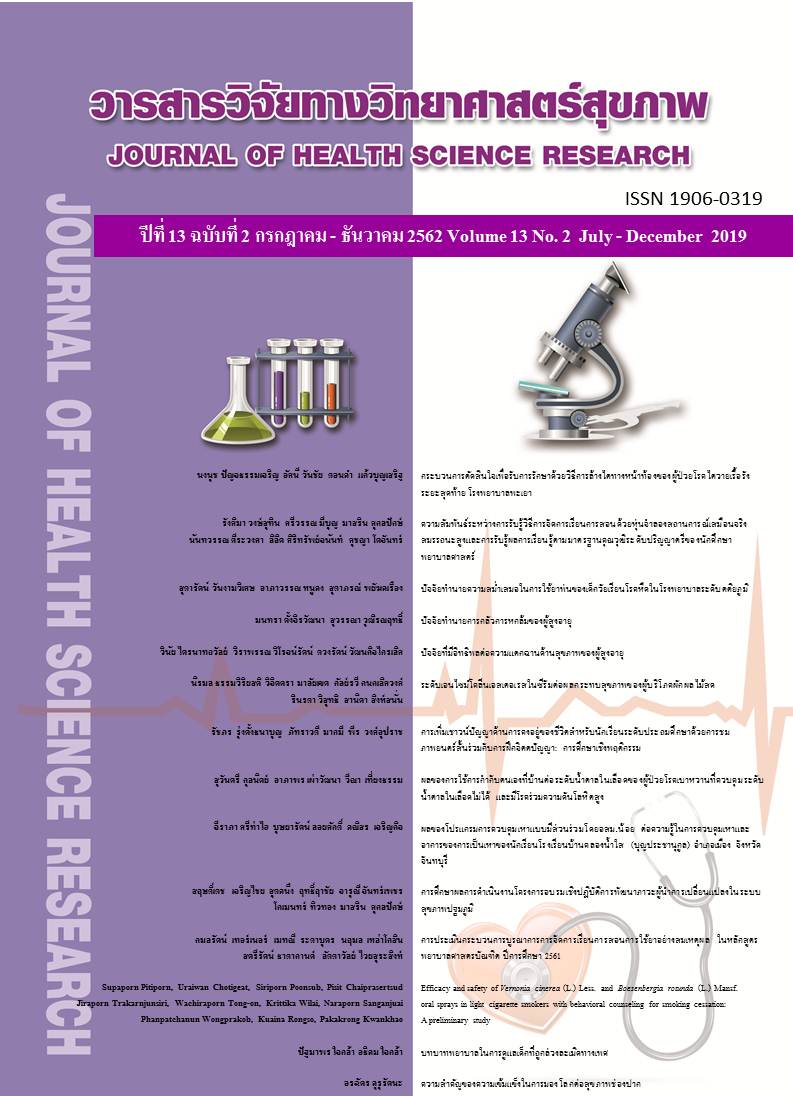การประเมินกระบวนการบูรณาการการจัดการเรียนการสอนการใช้ยาอย่างสมเหตุผล ในหลักสูตรพยาบาลศาสตรบัณฑิต ปีการศึกษา 2561
Main Article Content
บทคัดย่อ
การวิจัยนี้มีวัตถุประสงค์เพื่อประเมินกระบวนการบูรณาการการจัดการเรียนการสอนการใช้ยาอย่างสมเหตุผลในหลักสูตรพยาบาลศาสตรบัณฑิต ปีการศึกษา 2561 โดยใช้การวิจัยแบบผสมผสาน ประกอบด้วย 1) การเก็บรวบรวมข้อมูลเชิงปริมาณ ด้วยแบบสอบถามออนไลน์เกี่ยวกับกระบวนการบูรณาการการจัดการเรียนการสอนการใช้ยาอย่างสมเหตุผล จำนวน 11 ข้อ จากผู้บริหารและอาจารย์ของสถาบันการศึกษาพยาบาล 86 สถาบัน และได้รับการตอบกลับจำนวน 1,052 คน และ 2) การเก็บข้อมูลเชิงคุณภาพ โดยการสนทนากลุ่มกับผู้บริหารและอาจารย์พยาบาลจำนวน 50 คน ใช้แนวคำถามเกี่ยวกับประสบการณ์การจัดการเรียนการสอนการใช้ยาอย่างสมเหตุผล จำนวน 6 ข้อ การวิเคราะห์ข้อมูลเชิงปริมาณ ใช้จำนวนและร้อยละ การวิเคราะห์ข้อมูลเชิงคุณภาพใช้การวิเคราะห์เนื้อหา
ผลการวิจัยพบว่า ข้อมูลเชิงปริมาณและข้อมูลเชิงคุณภาพมีความสอดคล้องกัน ได้แก่สถาบันการศึกษาพยาบาลส่วนใหญ่มีการกำหนดนโยบาย กำหนดผู้รับผิดชอบการบูรณาการและการจัดการเรียนการสอน กำหนดสมรรถนะการใช้ยาอย่างสมเหตุผล กำหนดรายวิชาและประเด็นการเรียนรู้ กำหนดวัตถุประสงค์และผลการเรียนรู้ มีการจัดการเรียนการสอนที่เน้นผู้เรียนเป็นศูนย์กลาง และมีการประเมินผลที่หลากหลายที่สัมพันธ์กับสมรรถนะของการใช้ยาอย่างสมเหตุผล ข้อเสนอแนะ สภาการพยาบาลควรมีนโยบายสนับสนุนให้สถาบันการศึกษามีการดำเนินการอย่างต่อเนื่อง และสถาบันการศึกษาควรมีการกำหนดนโยบาย การพัฒนาอาจารย์ผู้สอน ส่งเสริมการจัดการเรียนการสอน และมีการประเมินผลการบูรณาการการใช้ยาอย่างสมเหตุผลอย่างชัดเจนและต่อเนื่อง
Article Details
บทความที่ได้รับการตีพิมพ์เป็นลิขสิทธิ์ของวิทยาลัยพยาบาลบรมราชชนนี จังหวัดนนทบุรี
ข้อความที่ปรากฏในบทความแต่ละเรื่องในวารสารวิชาการเล่มนี้เป็นความคิดเห็นส่วนตัวของผู้เขียนแต่ละท่านไม่เกี่ยวข้องกับวิทยาลัยพยาบาลบรมราชชนนี จังหวัดนนทบุรี และคณาจารย์ท่านอื่น ในวิทยาลัยฯ แต่อย่างใด ความรับผิดชอบองค์ประกอบทั้งหมดของบทความแต่ละเรื่องเป็นของผู้เขียนแต่ละท่าน หากมีความผิดพลาดใด ๆ ผู้เขียนแต่ละท่านจะรับผิดชอบบทความของตนเองแต่ผู้เดียว
References
2. Chantrapipat K, Fongthong T, Saokaew S. Effectiveness of the National Health Security Office’s Policy to Promote Rational Use of Antibiotics by Using Payment for Quality Performance. Thai Journal of Pharmacy Practice. 2017;9(2):499-515. (in Thai).
3. Chongtrakul P. Rational Drug Use in Primary care. 11th ed. Bangkok: Wanida Printing; 2017. (In Thai).
4. WHO. Medicines: rational use of medicines. Fact sheet No. 338 May 2010.
5. Rational Use of Drug Subcommittee. Teacher’s guide for promotion rational drug use. Nonthaburi: Food and Drug Administration, Ministry of Public Health, Thailand. 2017:1-8. (in Thai).
6. Thailand Nursing and Midwifery Council. Conclusion Integrating the Rational Drug Use Curriculum into the Bachelor of Nursing Science Program. [Internet]. 2018 [cited 2019 Mar 29]. Available from: https://www. tnmc. or.th/ news/ 110/
7. Ministry of Education. Teaching system. [Internet]. 2019 [cited 2019 Jul 23]. Available from: https://www.moe.go.th /moe/ th/news/.php?NewsID=11195Keynews_research
8. Salam A. Input, Process and Output: system approach in education to assure the quality and excellence in performance. Bangladesh Journal of Medical Science. 2019;14(1):1-2.
9. Suksan S. CIPP Model. [Internet]. 2002 [cited 2019 Sep 12]. Available from: https://www. clinictech.most.go.th/online/filemanager/fileclinic/F1/files/cipp%20model.pdf
10.Stufflebeam DL. The CIPP Model for Evaluation. In: T. Kellaghan, DL. Stufflebeam eds International Handbook of Educational Evaluation. Kluwer International Handbooks of Education. Springer, Dordrecht. 2003(9): 31-56.
11. Creswell JW, Plano Clark VL. Designing and Conducting Mixed Methods Research. Second edition. [Internet]. 2011 [cited 2019 Dec 18]. Available from: https://search-ebscohost-com.ezproxy.okcu.edu/login. aspx?
12. Giorgi A. Phenomenology and psychological research. Pittsburgh, Pennsylvania: Duquesne University Press; 1985.
13. Suebsook R, Siripirom W, Siribanpitak P. Management Strategies to Enhance Action Learning Abilities of Instructors in Nursing Schools. Kuakarun Journal of Nursing. 2017;24(1):7-27. (in Thai).
14. Sukim T, Pimoljinda T. The Implementation of Hospital Administrative Policy: A Case Study of Outpatient Department of Bangkok Hospital Network at The Kingdom of Cambodia. FEU Academic Rewiew Journal. 2016;10(3):143-54. (in Thai).
15. Rafique N, Sultan B, Ahmad S, Imran M. Teachers’ Role in Implementation of English Language Teaching Policies in Public Primary Schools of Rural Area in Punjab, Pakistan. Language in India. 2018; 18(4):252–60.
16. Punya A, Wattanatorn A, Kaewurai W, Pajanban P. The Development of Instructional Model on Small-Sized School. Journal of Education Narasuan University. 2013;5(4):96-104. (in Thai).
17. Lan WY. The effects of self-monitoring on students’ course performance, use of learning strategies. The Journal of Experimental Education. 1996;64(2):101.
18. Reece AJ, Butler MB. Virtually the Same: A Comparison of STEM Students Content Knowledge, Course Performance, and Motivation to Learn in Virtual and Face-to-Face Introductory Biology Laboratories. J Coll Sci Teach. 2017;46(3):83–9.
19. McCrory R, Putnam R, Jansen A. Interaction in online courses for teacher education: Subject matter and pedagogy. Journal of Technology and Teacher Education. 2008;16(2):155–80.
20. Postareff L, Parpala A, Lindblom-Ylänne S. Factors contributing to changes in a deep approach to learning in different learning environments. Learning Environments Research. 2015;18(3):315–33.
21. Kadri HM, Al-Moamary MS, Magzoub ME, Roberts C, Vleuten CPM. Students’ perceptions of the impact of assessment on approaches to learning: A comparison between two medical schools with similar curricula. Int J Med Educ. 2011;2:44–52.
22. Tongnuang P. Effects of student-centered teaching modules on learner knowledge and learner developments in pathophysiology subject among nursing students. Princess of Naradhiwas University Journal. 2553;2(1): 73-89. (in Thai).
23. Aziz S, Mahmood M., Rehman Z. Implementation of CIPP Model for quality evaluation at school level: A case study. Journal of Education and Educational Development. 2018;5(1):89–206.
24. Zhang G, Zeller N, Griffith R, Metcalf D, Williams J, Shea C, et al. Using the Context, Input, Process, and Product Evaluation Model (CIPP) as a Comprehensive Framework to Guide the Planning, Implementation, and Assessment of Service-learning Programs. Journal of Higher Education Outreach & Engagement. 2011;15(4):57–84.
25. Patil Y, Kalekar S. CIPP Model for school evaluation. Scholarly Research Journal for Humanity Science & English Language. 2014;2(10):2615-19.

